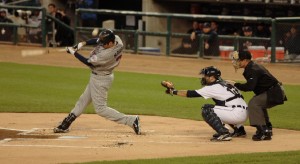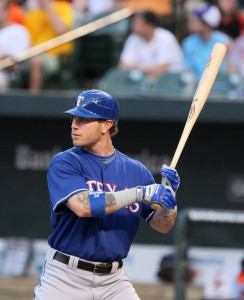With MLB Opening Day this coming Sunday, it seems appropriate to take a look at a few Spring Training surprises. So, here’s a handful of developments BBRT found interesting. (All 2016 statistics through March 27.) As you read through these, keep in mind:
1) Spring Training provides a pretty small sample size;
2) The competition can be uneven as teams “get a look” at players who may not be in their immediate major league plans;
3) Players show up at Spring Training at different levels of preparedness; and
4) Players – particularly pitchers – often sacrifice immediate performance to work on specific skills like mastering a new pitch or hitting to the opposite field.)
With all this in mind, here are a few developments BBRT found at least somewhat surprising.
(My) Twins’ starting pitching – a pleasant surprise.
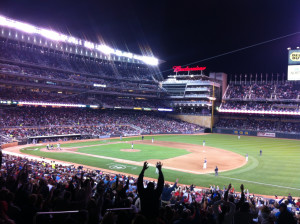
The pitching should be better at Target Field this season – at least if Spring Training is any indication.
Right off the top in terms of surprises is the performance of the Minnesota Twins’ pitching staff – particularly the starting rotation. (Being from Minnesota, the status of the Twins’ mound corps is of considerable interest to me.) Looking at the starters now locked in (slots 1-4), it’s been a surprisingly strong spring. Opening Day starter Erwin Santana’s spring ERA is 1.13 (down from an also strong 1.89 in 2015 Spring Training); Kyle Gibson sits at 1.53 (down from 3.51 last spring); Tommy Milone’s ERA is 2.40 (down from 3.60); and Phil Hughes is at 2.76 this spring (down from 5.28). Overall, the Twins’ ERA is 3.51 through March 27, down from 4.00 for the 2015 exhibition season.
It’s surprisingly good to be young and at third base.
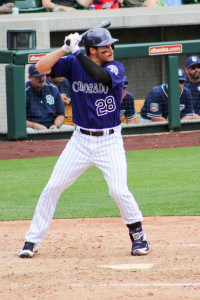
Nolan Arenado – a hor spring at the hot corner.
Photo: Jennifer Zambrano
Things are indeed hot at the hot corner this spring. That in itself is not unexpected, but just how strong the play of a couple of young third sackers has been is a little surprising. For example, looking at players with at least 40 Spring Training at bats, the top batting average goes to 24-year-old Rockies’ 3B Nolan Arenado at .553 (26-for-47, with three home runs and 12 RBI). Arenado, in just his third MLB season, is clearly establishing his dominance. Last season, he led the NL in HR’s (42) and RBI (130), while hitting .287, winning his third straight Gold Glove and making his first All Star team.
The second-highest average among players with at least 40 at bats belongs to the D-backs’ 26-year-old 2B/SS Jean Segura at .529 (27-for-51). Segura also has two home runs, ten RBI, 14 runs scored and five stolen bases in 15 games. Segura, acquired by the Rockies from the Brewers in an off-season trade, has a .266 average in four MLB seasons. However, he was an All Star in 2013, when he hit .294, with 12 home runs and 44 stolen bases in 146 games. The Rockies would love to see a return to that form. Note: Segura’s likely double play partner Nick Ahmed is also having a strong spring (.418 in 17 games through March 27).
Leadership in the other two Triple Crown categories (HR’s and RBI) also goes to a young third baseman – only this one is just beginning to show his major-league potential. The Phillies’ 23-year-old Maikel Franco has hit .298 thus far this spring, with an MLB-leading eight home runs and 20 RBI. As a rookie last season, Franco got into 80 games, hitting .280 with 14 HR’s and 50 RBI. Looks like he’s on his way to a solid career.
Currently tied for the second-most Spring Training HR’s at six are Seattle 2B Robinson Cano (.370-6-15) and Giants’ RF Hunter Pence (.484-6-11).
A surprising Story.
The Rockies’ 23-year-old SS Trevor Story has opened a few eyes this spring – going .381-5-12 in 16 games through March 27. The rookie may very well have captured the Colorado starting spot at short after going .279-20-80 (with 22 steals) at Double A and Triple A last season. Rookie of the Year candidate?
Did you catch this surprise?
D-backs’ catcher Wellington Castillo has been a monster this spring. In 11 games, he’s put up a .433 average, with three home runs, an MLB third-best 16 RBI and a spring-leading nine doubles. The 28-year-old is in his sixth MLB season (.251 career average), coming off a breakout year in 2015 (.255-17-50 in just 80 games). He looks poised to be an offensive force in 2016.
Surprising power from the White Sox.
No team has hit more home runs this spring than the White Sox – with 42 in 26 games. What makes this surprising is: 1) In the 2015 season, the White Sox finished 26th in HR’s with 136 in 162 games; 2) No White Sox player has hit more than four home runs this spring. (However, the following players have four each: 3B Matt Davidson; RF Avisail Garcia; SS Jimmy Rollins; 3B Tyler Saladino.)
More surprises? Here’s another Juan.
The Pirates are known for their work in helping pitchers reach their full potential. This year’s surprise project may be 6’4”, 250-pound right-hander Juan Nicosia. The 29-year-old has a career (five seasons) record of 22-25, with a 4.88 ERA. (However, he did spend four of those five seasons in Colorado – not exactly a pitcher’s paradise). Last season, working primarily as a reliever (53 games) with the Dodgers, he went 1-3, 3.86. Now with the Pirates, he’s been “lights out” this spring. In five appearances (four starts) he’s pitched 15 innings, fanned 24 (tied for MLB second-best) and has yet to give up a run.
Other pitchers with at least 10 innings pitched and an ERA of zero this spring: Matt Barnes, Red Sox (10 1/3 IP); Dana Eveland, Rays (10 1/3 IP); and Dallas Keuchel, Astros (10 IP).
Diamondbacks swinging hot bats.
Through March 27, the D-backs are leading all of MLB with a .321 team batting average, 338 hits, 206 runs scored, 76 doubles and 19 triples. They also are fifth in home runs (37). Take a look at some of these Spring Training averages: Jean Segura (.529 in 15 games); Yasmany Tomas (.452 in 10 games); Wellington Castillo (.433 in 11 games); Nick Ahmed (.418 in 17 games); Jack Reinheimer (.400 in 17 games); Jake Lamb (.391 in 19 games); Brandon Drury (.379 in 22 games) – and I could go on and on. The D-backs have 15 players who have played in at least 10 games and are hitting .315 or higher.
A surprising comeback.
D-backs’ lefty Patrick Corbin missed all of the 2014 season and half of 2015 following Tommy John surgery – but managed to finish 2015 at 6-5, 3.60 in 16 starts. He looks to be all the way back this spring – with a 1.71 ERA and 24 strikeouts (with only three walks) in 21 innings. The 26-year-old Corbin is in only his fourth MLB season and appears to be back in the form that earned him 14 wins and an All Star berth in 2013.
Note: The Spring Training strikeout leader through March 27 is the Angels’ Hector Santiago – with a 3.52 ERA and 26 whiffs in 23 innings.
A good surprise, and a crowded outfield.
The Nationals’ 25-year-old outfielder Michael Taylor is having a solid spring – .455-4-12 in 17 games – after hitting .229 with 14 home runs, 63 RBI and 16 steals in 138 games during the 2015 regular season. Still, there is plenty of competition for at bats in the Nats’ outfield – with Jayson Werth, newcomer Ben Revere and MVP Bryce Harper. A surprising Spring Training performance, however, may help ensure Taylor gets his share of plate appearances.
Of course, not all surprises are good ones. For example, who would have expected that (through March 27), the Giants’ potential starting rotation’s spring ERA’s would look like this: Jeff Samardzija – 7.20/25 IP; Jake Peavy – 7.43/23 IP; Madison Bumgarner – 11.12/11 1/3 IP; Johnny Cueto – 9.58/10 1/3 IP; Matt Cain – 12.15/5 2/3 IP).
Or consider this sampling of players who have played in 15 or more games and are hitting under .200: Orioles’ 1B Chris Davis; Cubs’ OF Jayson Heyward; Tigers’ OF Anthony Gose; Astros’ 1B Jon Singleton; Royals’ SS Alcides Escobar; Marlins’ OF Christian Yelich; Mets’ C Travis d’Arnaud; Yankees’ 1B Mark Teixeira; Cardinals’ 3B Matt Carpenter.
Here also, is a partial list of pitchers with ten or more innings and ERA’s over 7.00: Miguel Gonzalez, Orioles; Danny Salazar, Indians; Matt Shoemaker, Angels; Scott Kazmir, Dodgers; Wily Peralta, Brewers; Masahiro Tanaka, Yankees’; Colby Lewis, Rangers.
Of course, it is Spring Training – and things are likely to change a lot once the regular season gets underway. In fact, we can expect most of the players to play up to – or down to – their expected performance. No one will hit .500; no one will finish a full (qualifying season with a o.oo ERA; the list of under-.200 hitters is not likely to include any of the players listed above; and the list of 7.00+ ERA pitchers also is unlikely to include those listed here. So, I wouldn’t take these numbers – good or bad – very seriously. But until the soon-to-be-here season opener, it does give us something(s) to think about.
Thirty things BBRT would like to see this season – here.
Fan of trivia? -Quizzes here and here.
BBRT National League prediction here – American League Predictions here.
I tweet baseball @DavidBBRT
Member: Society for American Baseball Research (SABR); The Baseball Reliquary; Baseball Bloggers Alliance.

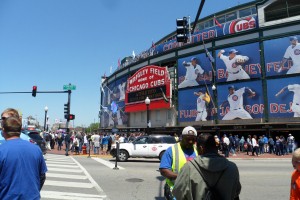 The Cubs have the longest World Series Championship drought in MLB – 107 years. Their last WS title came in 1908 (on the heels of a 1907 WS title). BBRT would like to see a World Series win at Wrigley in 2016 – and the Cubs may have the team to do it. They are coming off a 97-win campaign and have talented youngsters like Anthony Rizzo, Kris Bryant, Addison Russell, Jorge Soler and Kyle Schwarber in the lineup – not to mention Jason Heyward (signed from the division-rival Cardinals). They also boast a pitching staff with the likes of Jake Arrietta, John Lester, John Lackey (also signed from the Cardinals) and Hector Rondon. This could be the Cubs’ year – and BBRT would like to see it.
The Cubs have the longest World Series Championship drought in MLB – 107 years. Their last WS title came in 1908 (on the heels of a 1907 WS title). BBRT would like to see a World Series win at Wrigley in 2016 – and the Cubs may have the team to do it. They are coming off a 97-win campaign and have talented youngsters like Anthony Rizzo, Kris Bryant, Addison Russell, Jorge Soler and Kyle Schwarber in the lineup – not to mention Jason Heyward (signed from the division-rival Cardinals). They also boast a pitching staff with the likes of Jake Arrietta, John Lester, John Lackey (also signed from the Cardinals) and Hector Rondon. This could be the Cubs’ year – and BBRT would like to see it. Okay, really not likely, since the Royals’ 2015 home run leader was Kendrys Morales with just 22. Morales, however, has hit as many as 34 in a season (Angels, 2009). Why would BBRT like to see this unlikely occurrence? The Royals are the only team to never have a 40-homer performance. The team’s all-time single-season leader in round trippers is – wait for it – Steve “Bye Bye” Balboni, with 36 in 1985.
Okay, really not likely, since the Royals’ 2015 home run leader was Kendrys Morales with just 22. Morales, however, has hit as many as 34 in a season (Angels, 2009). Why would BBRT like to see this unlikely occurrence? The Royals are the only team to never have a 40-homer performance. The team’s all-time single-season leader in round trippers is – wait for it – Steve “Bye Bye” Balboni, with 36 in 1985.